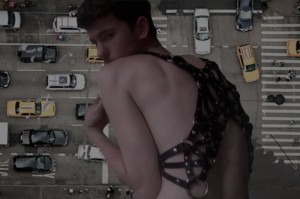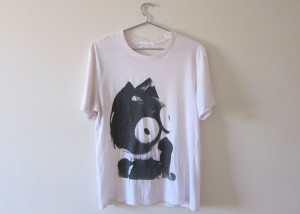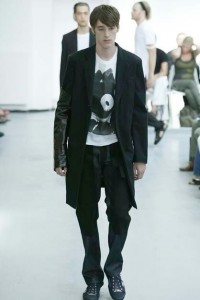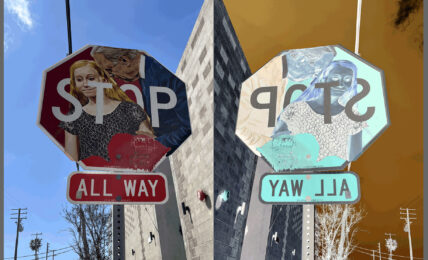Fashion is broadcasted to us through one-to-many1 platforms that construct visual environments around lifestyles that sell personal identities and prescribed values using clothing as signifiers. It is through editors, creative directors, stylists, photographers, critics, etc. that we are given our frame in which to interpret the output of a designer’s point-of-view every season. Fashion is a sterile microcosm that depends on the commodification of attaining and personifying idea(l)s within a certain logic of time. In this sense, the magazine industry takes design and forces it into an economy of packaging.[2] If clothes are inseparable from their wearer, what room does this model leave for our relationship with innovation and the “unwearable” besides as artifacts[3] stripped of their utility?

Caption: Camera/person/screen – we no longer make eye contact with the viewer but instead engage with the immediate feedback of our own images.
(Source: http://white-charcoal.tumblr.com/, used with permission.)
Self-publishing platforms on the Internet have allowed for the collective emergence of fashion’s marginalized have-nots.[4] The gatekeepers[5] of fashion rely on the function of clothing (to be worn) to define its significance,[6] but fashion online is consumed two-dimensionally as visual concepts and compositions divorced from the accumulation of specific material stuff. Fashion blogs offer first-person encounters at the intersection of consumption and production online—we (“the people”[7]) want to construct our own environments.
However, it is unrealistic to assume that user-generated content online is independent from the economic agents of consumer industries that increasingly include the commodification of personalities and user habits.[8] Fashion blogs are becoming “a large part of fashion’s cultural-ideological sphere controlled by transnational media and advertising (to use Leslie Sklair’s sociological terminology in regards to the systems of the capitalist class[9]) which in turn, dictates the subcultural hegemony of fashion and/or personal style blogs.”[10] Webcam software is the articulation of a born-digital[11] cultural ritual (the inversion of our physical relationship of camera hardware onto ourselves as subjects from an arm’s length), and in that sense it is a “metamedium.”[12] It is the very constraints of webcam software utilities (how we control the outcome of the content[13]) that allow users to navigate their relationship with fashion and their own digitality[14] in the social sphere of cross-platform (cross-intentional) fashion blogging.
1. Constructing Online Identities

Camera/person/screen – we no longer make eye contact with the viewer but instead engage with the immediate feedback of our own images.
(Source: http://scrapes.tumblr.com/, used with permission.)
Fashion blogs are particularly disabled by the software affordances of its popular publishing platforms. The early uses of Google’s Blogspot-specific social infrastructure (organized as a hierarchy of centralized user data vs. blog data) dictated the development of the “network”[15] isolated to one website. Given the nature of one-way links, blogrolls became less of a peer-reviewed portal to other points of view and more of a way to hemorrhage traffic towards emerging microcelebrities and their immediate strong ties.[16] The focus of the individual as opposed to the collective is certainly easy on blogs “which depend on web-based plugins for dynamic web possibilities beyond commenting and linking (both which also expect and require additional work from the visitor).”[17] In this model, comments are informational noise used as quantitative gages of popularity and influence. Many blogs adopt the formal rhetoric of magazines and in that sense force themselves into the role of dictating styles or trends at a micro-level. As the fashion industry attempted to understand and respond to the developing memes of Internet style, they in fact subsumed the new relatable icons of consumer culture as brands to sell clothing.[18] In this sense we are focused on the attainment of the same things: media accolades, celebrity privileges, social prestige, money, power, and visibility.

(Source: http://whatevskies.tumblr.com/, used with permission.)
Interestingly, websites with differing participatory architecture (Lookbook.nu, Pinterest.com) seem to attract the same people. Fashion bloggers, in their increasing attempt to sell themselves to a wider online audience (with the hopes of reaching an offline audience), use the same visual content across platforms without regards to their specific organizations. As we spread ourselves thin across the Internet we run into the problem of “curating” our personalities and turning them into brands. Industry involvement focuses solely on the appropriation of magazines in the form of blogs (platforms for advertising). At this point, is Tavi[19] a person, or is “tavi” a product, style, attitude, swear word, etc.?

The face is obscured in favor of compositional rendering.
(Source: http://sirromdrawde.tumblr.com/, used with permission.)
of a personally-owned blog page. It creates a common space for users to “occupy” (the dashboard) and facilitate new ways to respond and rearrange. Where filter bubbles invisibly threaten our control of our own content and degree of personalization,[20] these new verbs[21] go beyond immediate personal links and force the randomization of content to be viewed individually. Tumblr is based on a popularity that does not require a large online following, but instead allows for the rabid consumption of the “(disposable) cult image.”

(Source: http://thalamos.tumblr.com/, used with permission.)
The cult image severs the creator and the context from a single atom of content.[22] Tumblr consumes images at a rate not sustainable to the finite availability of existing material, and the cult image has begun to move away from editorial environments and towards the renewable visual cultures of informal creation. The cult image exists independently of the intentions of art and does not require a body of work to contextualize it or give it meaning. Images are defined through their instances (the time-constrained actions, the verbs) of creation. Communal recognition of an image through likes and reblogs becomes the incentive of its invention. Tumblr blogs often seamlessly assemble runway images and magazine editorials with the new vernacular of creativity: webcam photography.
2. The New Intelligence
In his 2008 article “Is Google Making Us Stupid?” Nicholas Carr details his own personal tragedy in Internet-habits degrading his ability to read. Unfortunately, Carr also attempts to extend this anecdotal theory to the umbrella of all online media users. He laments the psychological comforts of the reading past: “Our ability to interpret text, to make the rich mental connections that form when we read deeply and without distraction, remains largely disengaged.”[23] It is a true failure in thinking when we begin to define our technologies in binary manners like “smart” or “stupid.” In 2010 the PEW Internet Project’s survey response [site no longer live][24] to the article found that the overwhelming majority of responding experts disagree.

Instead, intelligence is redefined by the new modes in which we search and find information in the 21st century. Christine Greenhow speculates that “we might agree on ‘smart’ as something like a ‘networked’ or ‘distributed’ intelligence where knowledge is our ability to piece together various and disparate bits of information into coherent and novel forms.”[25] This is exactly the intelligence of

Creating imaginary and 3-D environmental relationship. (Source: http://girlinternet.tumblr.com/, used with permission.)
microblogging. The cross-website platform of Tumblr that allows users to instantly rip content from outside digital sources and force them into the network of images cultivates a sense of value in “original posted content” separate from “original content”. Bloggers begin to grapple with the ethics of citing the poster equivalent to the content-creator where the chain of production is not at all a chain. Finding and arranging visual artifacts on a webpage becomes a valuable social skill, and members of communities with ambient memory intelligences and visual remix reasoning become the gurus of self-expression. Users who have developed the ability to search for content from sources and sources from content are able to experience and interpret a wider selection of subcultural outputs.
3. Remix Culture

Caption: Creating imaginary and 3-D environmental relationship. (Source: http://skelestun.tumblr.com/)
The gate-keeping nature of the fashion industry precludes it from discourse of remixability, although it has attempted to appropriate and manufacture it in recent years (for example Steven Meisel’s 2009 Meiselpic [link no longer active] 2007 Live on the Web editorials for Vogue Italia).[26] Fashion appears to be preoccupied with itself as a job-making machine as opposed to one of form-making. “Stylist,” “photographer,” “editor,” and “creative director” are obtuse titles that increasingly refer not to a creative class but to the systemic production of filters or tweaks.
The most important aspect of “remixing” visual content on fashion blogs is the dialog created through these associations, and the ways in which they meld our approaches to style and art. Does photography still function as a medium in the 21st century, or has it been reduced to its commercialism? Webcam photography and other informal modes of creating, viewing, and relating to theoretical physical objects or space work to examine their places in the context of questions like these.
in). It is in this sense that we can speak of the “webcam point of view” (or the gaze from the top of your computer) – but as the webcam looks at us as input, for the first time we can look at the screen to control the output.[27] Why do current Apple Macbook models have 720p webcams, while the iPhone 4s has an 1080p camera? Is it because there is a current cultural value in the grainy, light-sensitive 640×480 snapshots we broadcast across the web? In a way, webcam fashion photography has taken on the aesthetic of camgirl voyeurism without the actual exchange or reveal. There is almost a severing of the “person” from the “body”, perhaps as a way to understand our visual and intellectual relationships with the body and beauty standards of the fashion industry and mass distribution culture. It is a deeply personal medium that is at the same time anonymous it is the visual description of isolation, not inclusion, that is so attractive about the portrayal of ourselves through webcams. It is the intentional curation of personalities as brands online that webcam blogging aims to counter.

(Source: ebay, used with permission from http://sirromdrawde.tumblr.com/)
The almost live delay of constant snapshots through webcam software has also given way to user experimentation with moving image. The Thought Catalog argues that the new wave of pop-culture gif obsession is analogous to the “gradual but sensible evolution from 1400 words to 140 characters as the norm”, that “migrating toward a sort of video-shorthand seems a similarly natural response.”[28] Bloggers, on the other hand, organize series of still webcam pictures into short frame-by-frame animations in order to create a three-dimensional but equally obscure portraits of themselves. Increasingly the “digital sublime” is the meaningless ephemera archived through our tweets, status updates, blog posts, etc.

(Source: ebay, used with permission from http://sirromdrawde.tumblr.com/)
The flawed form of webcam background-detectable filters have also taken on significance, perhaps in the most direct intersection between a widely used technology, the lacking affordances of that software controlled by outside programmers, and how we use these to construct digital 2-D environments. In the way entertainment industries lay backdrops to sell lifestyles, the use of filters in webcam photography reacts to the assumption of a passive buyer and the new digital culture we teach ourselves how to use. For the first time, users are relating to the superficiality of celebrity culture in a superficial way – they are evening the playing field as both producers and consumers. They are finding the cracks in the constant stream of commercials, advertisements, advertorials, etc. and are using them to both ask and answer questions about personal identity in the digital future.
Users online attracted by the sensibilities lurking below the sameness (“commercially successful design”) of fashion[29] have begun to use the tools provided to them to navigate their relationship with visual-economic industries beyond that of a classic consumer role. In the way designers are controlled by corporate advertising-potential (against the avant-garde), so too are the consumers of images whose relationship with clothing has been separated several degrees away from their bodies. Who then becomes the true consumer of Mcqueen’s “Plato’s Atlantis”, of Kawakubo’s “Lumps and Bumps”, of Margiela’s Tabi boots? Where is the space for designers or craftsmen of the fantastic, where the fantastic is increasingly production-cost heavy and commercially unsuccessful? Users online desire “ideas” instead of “products”. The inaccessibility of fashion overlooks those who do not have the means to buy themselves “in”, but for the first time it is the consumer of material goods/producer of digital means that begins to lay the groundwork for examining the whole of fashion and style (including the discarded and the recycled). Webcams require bodies to work (physically) and to capture (digitally); everyone has a body. The webcam POV in fashion blogging should be considered a facet in defining the generational ideologies affected by colloquial personal bloggers with an internet-based audience and developing relationships to forms independent of their form.
- A webcam in Williamsburg, NY that is situated over one of the city’s busiest streets snaps candid photos of pedestrians to observe styles, cultures, and identities.
- A blog post critiquing the phenomenon of “virtual fitting rooms” on fashion websites.
- An online publication for teenage girls featuring writing, photography, illustrations, videos, and more.
- A multi-dimensional video platform and creative community through which style is explored as an amalgam of an individual’s passion, imagination, and self-expression.
- An evolving collaboration between two clotheshorse academics to discuss the politics, aesthetics, histories, theories, cultures and subcultures that go by the names “fashion” and “beauty.”
- Independent Fashion Bloggers (IFB) cultivates a community for fashion bloggers to share their experiences and create a resource so everyone can build a better blog.
[1] Leah Lievrouw, “Information Resources and Democracy”, Journal of the American Society for Information Studies (1994), pg 352
[2] Hal Foster, “Design and Crime”, from Design and Crime (and Other Diatribes) (Verso, 2002),
[3] “Made from samples which come from already existing database of culture”, Lev Manovich, Software Takes Command (2008), pg 202
[4] “This is the world of scarcity. Now, with online distribution and retail, we are entering a world of abundance.” Chris Anderson, “The Long Tail”, Wired, October 2004, http://www.wired.com/wired/archive/12.10/tail.html (accessed March 18, 2012).
[5] Atle Hauge, “Gatekeepers and Knowledge Diffusion in the Fashion Industry” (Paper presented at DRUID-DIME Academy Winter 2006 PhD Conference, January 26 – 28, 2006)
[6] John Heskett, Design: A Very Short Introduction (New York: Oxford University Press, Inc., 2002), 26-27. Assuming the definition of contemporary design as utility and significance there is no doubt that the function of clothing is to be worn, but clothing online both exists and is used in the form of images
[7] “A relatively small number of people vote in … elections. The cycle of elections has become totally professionalized and routinized. Most of us think this is democracy”, Lawrence Lessig, Free Culture (2006), pg 42
[8] Lev Manovich, Software Takes Command (2008), pg 227
[9] Leslie Sklair, “The Transnational Capitalist Class and the Discourse of Globalization”, Published with permission by The Global Site. Accessed March 18, 2012, http://www.theglobalsite.ac.uk/press/012sklair.htm
[10] Leslie Bloomfield, “Webcam (Fashion) Blogging Manifesto”, 2010-11, http://reallygoodart.com/cam.html
[11] Lev Manovich, Software Takes Command (2008), pg 18
[12] “After representational formats of older media types, the techniques for creating content in these media and the interfaces for accessing them were unbundled from their physical bases and translated into software, these elements start interacting producing new hybrids. This, for me, is the essence of the new stage of a computer metamedium in which we are living today”, Lev Manovich, Software Takes Command (2008), pg 78
[13] “There is no such thing as ‘digital media.’ There is only software – as applied to media data (or ‘content’)”, Lev Manovich, “There is Only Software” from Software Takes Command draft. Accessed March 18, 2012, http://www.manovich.net/DOCS/Manovich.there_is_only_software.pdf
[14] Nicholas Negroponte, Being Digital (1995)
[15] “The ‘mass’ view of society and media is being challenged by a more complex, dynamic view of society as made up of constantly reorganizing, interrelated networks of nodes, links, and flows”, Leah Lievrow, “Getting People on the ‘Street’: Mediated Mobilization” in Alternative and Activist New Media (2011)
[16] Clay Shirky, “Fitting Our Tools to a Small World” in Here Comes Everybody (2008)
[17] Leslie Bloomfield, http://archive.varsity.co.uk/752.pdf (interview manuscript)
[18] See: nowmanifest.com
[19] http://en.wikipedia.org/wiki/Tavi_Gevinson
[20] “The Daily Me”
[21] “We now have to consider larger media environments which integrates the functions of creating media, publishing it, remixing other people’ media, discussing it, keeping up with friends and interest groups, meeting new people, and so on”, Lev Manovich, Software Takes Command (2008), pg 193
[22] Lev Manovich, Software Takes Command (2008), pg 3
[23] Nicholas Carr, “Is Google Making Us Stupid?”, The Atlantic, July/August 2008. Accessed March 18, 2012, http://www.theatlantic.com/magazine/archive/2008/07/is-google-making-us-stupid/6868/
[24] Janna Quitney Anderson, Elon University, and Lee Rainie, Pew Internet & American Life Project, “Does Google Making Us Stupid?”, Pew Internet & American Life Project, February 19, 2010. Accessed March 18, 2012, http://pewresearch.org/pubs/1499/google-does-it-make-us-stupid-experts-stake
[25] Janna Quitney Anderson, Elon University, and Lee Rainie, Pew Internet & American Life Project, “Does Google Making Us Stupid?”, Pew Internet & American Life Project, February 19, 2010. Accessed March 18, 2012, http://pewresearch.org/pubs/1499/google-does-it-make-us-stupid-experts-stake
[26] Jenna Sauners, “Who Owns ‘90s Nostaliga?”, Jezebel, March 13, 2012. Accessed March 18, 2012, http://jezebel.com/5893303/who-owns-90s-nostalgia
[27] Camera > Person > Screen. Subjects do not make eye-contact with the webcam in the way we make eye-contact with cameras
[28] Leigh Alexander, “Why We Love Animated GIFs”, Thought Catalog, May 24, 2011. Accessed March 18, 2012, http://thoughtcatalog.com/2011/why-we-love-animated-gifs/



